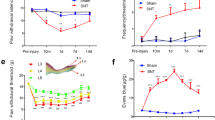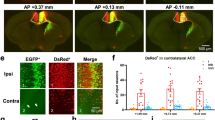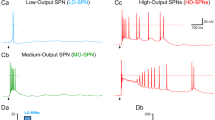Abstract
Glutamate, the major excitatory neurotransmitter in the central nervous system, activates three different receptors that directly gate ion channels, namely receptors for AMPA (α-amino-3-hydroxy-5-methyl isoxozole propionic acid), NMDA (N-methyl-D-aspartate), and kainate, a structural analogue of glutamate. The contribution of AMPA and NMDA receptors to synaptic transmission and plasticity is well established1. Recent work on the physiological function of kainate receptors has focused on the hippocampus2, where repetitive activation of the mossy-fibre pathway generates a slow, kainate-receptor-mediated excitatory postsynaptic current (EPSC)3,4,5. Here we show that high-intensity single-shock stimulation (of duration 200 microseconds) of primary afferent sensory fibres produces a fast, kainate-receptor-mediated EPSC in the superficial dorsal horn of the spinal cord. Activation of low-threshold afferent fibres generates typical AMPA-receptor-mediated EPSCs only, indicating that kainate receptors may be restricted to synapses formed by high-threshold nociceptive (pain-sensing) and thermoreceptive primary afferent fibres. Consistent with this possibility, kainate-receptor-mediated EPSCs are blocked by the analgesic µ-opiate-receptor agonist Damgo and spinal blockade of both kainate and AMPA receptors produces antinociception. Thus, spinal kainate receptors contribute to transmission of somatosensory inputs from the periphery to the brain.
This is a preview of subscription content, access via your institution
Access options
Subscribe to this journal
Receive 51 print issues and online access
$199.00 per year
only $3.90 per issue
Buy this article
- Purchase on Springer Link
- Instant access to full article PDF
Prices may be subject to local taxes which are calculated during checkout





Similar content being viewed by others
References
Bliss, T. V. P. & Collingridge, G. L. Asynaptic model of memory: long-term potentiation in the hippocampus. Nature 361, 31–39 (1993).
Lerma, J., Morales, M., Vicente, M. A. & Herreras, O. Glutamate receptors of the kainate type and synaptic transmission. Trends Neurosci. 20, 9–12 (1997).
Castillo, P. E., Malenka, R. C. & Nicoll, R. A. Kainate receptors mediate a slow synaptic current in hippocampal CA3 neurons. Nature 388, 182–186 (1997).
Vignes, M. & Collingridge, G. L. The synaptic activation of kainate receptors. Nature 388, 179–182 (1997).
Mulle, C. et al. Altered synaptic physiology and reduced susceptibility to kainate-induced seizures in GluR6-deficient mice. Nature 392, 601–605 (1998).
Yaksh, T. L. & Malmberg, A. B. in Textbook of Pain (edited by Wall, P. D. & Melzack, R.) 165–200 (Churchill Livingstone, New York, (1994)).
Yoshimura, M. & Jessell, T. M. Amino acid-mediated EPSPs at primary afferent synapses with substantia gelatinosa neurones in the rat spinal cord. J. Physiol. (Lond.) 430, 315–335 (1990).
Kumazawa, T. & Perl, E. R. Excitation of marginal and substantia gelatinosa neurons in the primate spinal cord: indications of their place in dorsal horn function organization. J. Comp. Neurol. 177, 417–434 (1978).
Light, A. R., Trevino, D. L. & Perl, E. R. Morphological features of functionally defined neurons in the marginal zone and substantia gelatinosa of the spinal dorsal horn. J. Comp. Neurol. 186, 151–171 (1979).
Bleakman, D. et al. Activity of 2,3-benzodiazepines at naive rat and recombinant human glutamate receptors in vitro; stereospecificity and selectivity profiles. Neuropharmacol. 35, 1689–1702 (1996).
Pelletier, J. C., Hesson, D. P., Jones, K. A. & Costa, A. -M. Substituted 1,2-dihydrophthalazines: potent, selective, and noncompetitive inhibitors of the AMPA receptor. J. Med. Chem. 39, 343–346 (1996).
Paternain, A. V., Morales, M. & Lerma, J. Selective antagonism of AMPA receptors unmasks kainate recceptor-mediated responses in hippocampal neurons. Neuron 14, 185–189 (1995).
Wilding, T. J. & Huettner, J. E. Differential antagonism of alpha-amino-3-hydroxy-5-methyl-4-isoxazolepropionic acid-preferring and kainate-preferring receptors by 2,3-benzodiazepines. Mol. Pharmacol. 47, 582–587 (1995).
Jones, K. A., Wilding, T. J., Huettner, J. E. & Costa, A. -M. Desensitization of kainate receptors by kainate, glutamate and diasteriomers of 4-methylglutamate. Neuropharmacol. 36, 853–863 (1997).
Wilding, T. J. & Huettner, J. E. Activation and desensitization of hipocampal kainate receptors. J. Neurosci. 17, 2713–2721 (1997).
Partin, K. M., Patneau, D. K., Winters, C. A., Mayer, M. L. & Buonanno, A. Selective modulation of desensitization at AMPA versus kainate receptors by cyclothiazide and concanavalin A. Neuron 11, 1069–1082 (1993).
Todd, A. J., Spike, R. C., Price, R. F. & Neilson, M. Immunocytochemical evidence that neurotension is present in glutamatergic neurons in the superficial dorsal horn of the rat. J. Neurosci. 14, 774–784 (1994).
Tölle, T. R., Berthele, A., Zieglgänsberger, W., Seeburg, P. H. & Wisden, W. The differential expression of 16 NMDA and non-NMDA receptor subunits in the rat spinal cord and in periagqueductal gray. J. Neurosci. 13, 5009–5028 (1993).
Wisden, W. & Seeburg, P. H. Acomplex mosaic of high-affinity kainate receptors in rat brain. J. Neurosci. 13, 3582–3598 (1993).
Petralia, R. S., Wang, Y. -X. & Wenthold, R. J. Histological and ultrastructural localization of the kainate receptor subunits, KA2 and GluR6/7, in the rat nervous system using selective antipeptide antibodies. J. Comp. Neurol. 349, 85–110 (1994).
Fitzgerald, M., Butcher, T. & Shortland, P. Development changes in the laminar termination of A fibre cutaneous sensory afferents in the rat spinal cord dorsal horn. J. Comp. Neurol. 348, 225–233 (1994).
Coggeshall, R. E., Jennings, E. A. & Fitzgerald, M. Evidence that large myelinated primary afferent fibers make synaptic contacts in lamina II of neonatal rats. Brain Res. Dev. Brian Res. 92, 81–90 (1996).
Baba, H., Yoshimura, M., Nishi, S. & Shimoji, K. Synaptic responses of substantia gelatinosa neurons to dorsal column stimulation in rat spinal cord in vitro. J. Physiol. (Lond.) 478, 87–99 (1994).
Huang, L. -Y. M., Carlton, S. M. & Willis, W. D. Identification of spinothalamic tract cells in fresh, unfixed rat spinal cord. J. Neurosci. Methods 14, 91–96 (1985).
Zhuo, M. NMDA receptor-dependent long term hyperalgesia after tail amputation in mice. Eur. J. Pharmacol. 349, 211–220 (1998).
Cao, Y. Q. et al. Primary afferent tachykinins are required to experience moderate to intense pain. Nature 392, 390–394 (1998).
De Felipe, C. et al. Altered nociception, analgesia and aggression in mice lacking the receptor for substance P. Nature 392, 394–397 (1998).
Li, P. & Zhuo, M. Silent glutamatergic synapses and nociception in mammalian spinal cord. Nature 393, 695–698 (1998).
Acknowledgements
We thank D. Leander for GYKI 53655. This work was supported in part by grants from NIDA (to M.Z.) and NINDS (to J.E.H.) of the NIH.
Author information
Authors and Affiliations
Corresponding author
Rights and permissions
About this article
Cite this article
Li, P., Wilding, T., Kim, S. et al. Kainate-receptor-mediated sensory synaptic transmission in mammalian spinal cord. Nature 397, 161–164 (1999). https://doi.org/10.1038/16469
Received:
Accepted:
Issue Date:
DOI: https://doi.org/10.1038/16469
This article is cited by
-
Neuronal Adenylyl Cyclase Targeting Central Plasticity for the Treatment of Chronic Pain
Neurotherapeutics (2020)
-
NMDA Receptor Dependent Long-term Potentiation in Chronic Pain
Neurochemical Research (2019)
-
Top-down descending facilitation of spinal sensory excitatory transmission from the anterior cingulate cortex
Nature Communications (2018)
-
Glutamate and Its Receptors as Therapeutic Targets for Migraine
Neurotherapeutics (2018)
-
Characterization of serotonin-induced inhibition of excitatory synaptic transmission in the anterior cingulate cortex
Molecular Brain (2017)
Comments
By submitting a comment you agree to abide by our Terms and Community Guidelines. If you find something abusive or that does not comply with our terms or guidelines please flag it as inappropriate.



